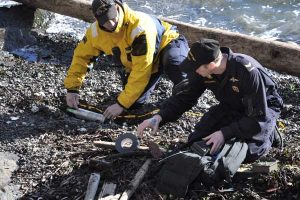Divers clear washed up ordnance from beach
By Lookout on Feb 18, 2013 with Comments 0

LS Bob McConnell and LS Andy O’Brien of Fleet Diving Unit (Pacific) wrap the remains of a marine locator marker in dirt and gun tape before transporting it for disposal.
LS Bob McConnell and LS Andy O’Brien of Fleet Diving Unit (Pacific) (FDU (P)) travelled to Prevost Island Feb. 7 in response to a call from a member of the public. Their mission: to find and dispose of a military marine locator marker that had been spotted on shore.
Used to mark locations on the water of people in distress, marine locator markers (commonly known as smoke markers) are essential to marine search and rescue operations to mark potential dangers on or in the water, especially at night.
Normally, markers will fill with water and sink once they have completely burned, but sometimes they wash ashore, requiring disposal from trained personnel. That is where members from FDU (P) come in.
In response to information received by local authorities, members of the unit trained in unexploded ordnance disposal will travel to the location of the reported marker, find it and dispose of it properly.
“If it is in a safe area we would dispose of it by using a small quantity of explosive on the marker as a precautionary measure,” says LS McConnell. “This helps safe-guard members of the public from any potential danger.”
On Prevost Island, LS McConnell and LS O’Brien worked quickly to locate the marker, safely move it to the beach, detonate it, and, once it was safe, wrap the remains of the marker with dirt and gun tape to transport it for final disposal.
“This type of call is probably the most common we receive at the Fleet Diving Unit,” said LS O’Brien. “It is very important these markers are disposed of properly, and we thank the public for their help.”
If members of the public come across a marine locator marker they should note where it is located, leave it alone, and call the police who can coordinate with the navy to have it disposed of. Each marker is clearly marked with directions to help protect and aid members of the public who may encounter these devices.
-Capt Jenn Jackson, Base Public Affairs Officer
Filed Under: Top Stories
About the Author:





